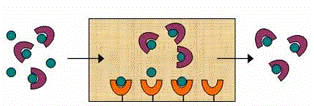Chemistry, Department of: Faculty Series

David Hage Publications
Document Type
Article
Date of this Version
10-31-2019
Citation
HHS Public Access Author manuscript Anal Chim Acta. Author manuscript; available in PMC 2020 October 31. Published in final edited form as: Anal Chim Acta. 2019 October 31; 1078: 189–199. doi:10.1016/j.aca.2019.05.060.
Abstract
Silica-based lectin microcolumns were developed and optimized for the separation and analysis of glycoform fractions in alpha1-acid glycoprotein (AGP) based on both the degree of branching and level of fucosylation. Concanavalin A (Con A) and Aleuria Aurantia lectin (AAL) were immobilized onto HPLC-grade silica by reductive amination and packed into 2.1 mm i.d. × 5.0 cm microcolumns. Factors examined for these microcolumns include their protein content, binding capacity, binding strength and band-broadening under isocratic conditions (Con A) or step elution conditions (AAL) and in the presence of various flow rates or temperatures. These factors were examined by using experiments based on frontal analysis, zonal elution, peak profiling and peak decay analysis. Up to 200 μg AGP could be loaded onto a Con A microcolumn and provide linear elution conditions, and 100 μg AGP could be applied to an AAL microcolumn. The final conditions for separating retained and non-retained AGP glycoform fractions on a Con A microcolumn used a flow rate of 50 μL min−1 and a temperature of 50 °C, which gave a separation of these fractions within 20 min or less. The final conditions for an AAL microcolumn included a flow rate of 0.75 mL min−1, a temperature of 50 °C, and the use of 2.0 mM L-fucose as a competing agent for elution, giving a separation of non-retained and retained AGP glycoforms in 6 min or less. The inter-day precisions were ± 0.7–4.0% or less for the retention times of the AGP glycoforms and ± 2.2–3.0% or less for their peak areas.


Comments
Copyright 2019 Elsevier. Used by permission.